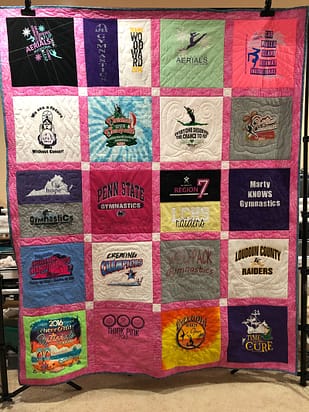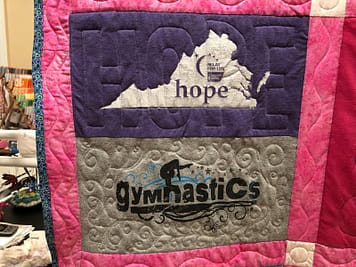
Most of us have a T-shirt collection. They were gathered as mementoes from events in our lives, places we visit or causes we support. Some of them are lucky enough to be worn. But most find their way into a lonely, dark closet, box or drawer, never to be worn again. Why not reawaken those memories by turning the T-shirts into a quilt that you can wrap yourself in?
Recently, I had the honor of making one of those quilts for a special person. As her mother showed me the T-shirts, she told me what each of the T-shirts represented in her daughter’s life. It was a beautiful experience to share with someone. I took what she had told me and the images on the T-shirts to create a memory quilt, which we hope she loves.
For those interested in making a T-shirt quilt on their own, there are a plethora of YouTube and internet articles on the subject. Many of them give conflicting information, so understand that the authors are presenting what worked best of them. Everyone has their own tricks. Here are a few of mine:
- Wash all fabrics before starting the project. The T-shirts are most likely a cotton/polyblend that have already shrunk, but the backing, sashing, border and binding will need to be “shrunk” before sewing. This will minimize a puckered look to the quilt after later washings.
- Cut the T-shirts apart before cutting to block size. Some T-shirts have the wanted design n the front and some on the back. The ones on the front will be limited by the sleeves and neckline. Then, trim the back or front to the desired size using a template. Use care not to stretch the fabric as it will retract after cutting and give an odd-sized block.
- Using a pressing cloth, press a lightweight interface onto the back of the block. The interfacing should be about an inch smaller than the block. This will minimize bulk at the seams.
- Use blender fabrics that highlight the blocks rather than detract from them. Blenders have a little pattern so have more depth than plain fabrics but aren’t distracting like most prints.
- When sewing frames or sashing onto the block, put the t-shirt material on the bottom near the feeddogs. The feeddogs will grip the stretchy fabric while the quilt fabric glides over the top. this minimizes wrinkles in the seams.
- Have a Purple Thang or other tool available to guide the fabric during sewing.
- For T-shirts with smaller designs, combine them into a larger block. It adds interest.
- When quilting, use care when sewing through a design. The ink may melt and transfer to other areas. Also, it will be difficult to rip out mistakes as the holes in the ink will be visible.
- I prefer to use custom quilting to add character to the quilt rather than using edge-to-edge quilting. It takes more time, but enables the quilter to add personal notes or fill the space with complimentary designs.


Custom T-shirt quilts are a great gift for someone you care about or yourself. If you have questions about making a quilt, or having one made for you. please contact me!
Happy Quilting
Laureen
